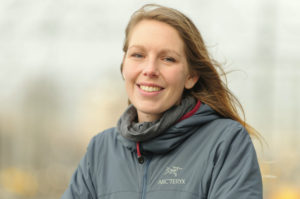“Alaska’s suicide prevention and someone-to-talk to line”
That’s the subtitle of ‘Careline Alaska’ with which they aim to reach not only those in deep crisis but also people who ‘have a shitty day’ or feel lonely, sad, or depressed. People should feel encouragedto call them, even when they are not actively suicidal. Careline is the suicide prevention organization of Alaska that is part of the ‘National Suicide Prevention Lifeline Network’. In Fairbanks, in the heart of Alaska, I met with Susanne Marchuk, director of Careline Alaska.
But first a reintroduction.
Who am I and why do I write about suicide prevention?
Because this is my first article on this subject ‘on the road’, it’s probably useful to take a moment and shine a light on those things.
My name is Hera van Willick and I was born and raised in the Netherlands. After several bicycle tours through Europe and Asia, I am now cycling for indefinite time around the world, or till I find something I’d rather do.
At the age of 24 as well as 28 I lost a loved one to suicide. My uncle Will and my close friend Fokke.
A combination of understanding and incomprehension, sadness and anger, interest in the human psyche and the insight Fokke actively provided me in his struggles with life, his illness, the mental health care, and his death wish, made me feel the need to participate in suicide prevention.
It became clear to me how much more has to be done and changed before there will be no more deaths in the horrific way of suicide: a lot of work, but within our power.
The best way to provide help, care and do meaningful work is from a place where you feel strong and happy. For me, that’s on my bike in the farthest corners of the world.
My way to do my part from that exceptional position? To learn and share knowledge and create awareness about suicide, everywhere around the world!
Now let’s go back to Alaska!
What did I know about ‘suicide in Alaska’ before I came here?
Just that the rate was proportionally high. That’s it.
Curious what the average Alaskan could tell me about the subject I asked several people I met about it.
What I learned from them (and you’ll read later if they were right) was that it’s mainly a big problem within the Native community, often living in villages away from the non-native community and not connected to the road system.
Nobody could exactly tell me why it’s such a big problem within this particular group of people. Though several did refer to substance abuse, sexual abuse and domestic violence as common problems within these communities.
Most people I talked to were surprised about my project and unfamiliar with suicide prevention (organisations).
Nobody shared a personal story concerning suicide with me.
And I felt I wasn’t as comfortable to ask about it in this new environment and society. An interesting discovery about myself.
While Googling I came across several local organisations who provide help for ‘suicide survivors’ (people who have lost a loved one to suicide). There’s several support groups, often with a religious background and funding.
In Wasilla I spoke with a woman who organizes support group meetings.
She also told me about the ‘Alaska Police & Fire Chaplains’. Something completely new and surprising to me. Chaplains that are trained to give support at traumatic events. They also lead support groups for survivors and offer training in suicide prevention and support to people in crisis, or to family members right after a suicide. This support is for everybody regardless of faith, sex or gender.
To check the information I gathered, and to hear about their work, I visited ‘Careline Alaska’ in Fairbanks.
Susanna Marchuk, director of Careline, showed me around their workplace. Two offices, two call rooms and a meeting room. All in all, not very big. There are two phone lines that are answered by employees from very different backgrounds, but all selected and trained to do this particular work. 24/7 all year round the phones are manned.
Susanna confirms the magnitude of the problem. Alaska has one of the highest suicide rates in the United States. The suicide rate among Alaskan Natives is 3 times that of non-Native Alaska residents and five times the national rate. But neither she could tell me the exact reason for that. She did tell me that they don’t consider substance abuse and violence within the communities as a cause of the high suicide rate, but rather as other results of the internal problems of the communities. A cause could be the accumulation of trauma through several generations, which started with the white people conquering Alaska and making drastic changes. A different factor could be ‘shame’. There are some strict taboos within these communities, and it’s hard to find someone you trust to talk to who isn’t a relative or in any other way takes part in your family’s and close acquaintances’ daily lives. A last important factor is the lack of awareness and knowledge about the problem and the absence of mental healthcare. Small organisations and initiatives are working hard to make a change, and also make people aware of ‘Careline Alaska’ as a way to reach out for help.
In Alaska, youth have the highest risk to die by suicide. Careline recently launched a ‘textline’ through which people can contact Careline by SMS. This new initiative turns out to be more accessible for the Alaskan youth.
A big challenge for Careline is to create enough publicity to reach everyone in the state. Alaska is a very big and spread out state, with different news channels and newspapers in each community or borough. A part of its residents are not connected to the road system or the telephone network. This makes the work of Careline Alaska different to other Lifeline Network centers in the U.S. Callers from Alaska get automatically connected to the call center in Fairbanks. The person answering the phone there knows, better than a colleague from Florida or Idaho, what it’s like to live in Alaska and what circumstances could possibly play a role in the callers’ problems. One of the workers stayed on the phone with a caller from a rural community overnight, waiting for the sun to come up and the possibility to send in help by helicopter. Other times a family member has been asked to sit with the caller, or Careline would check in with him or her every half hour to get through the night safely till the situation would improve or help would arrive.
One thing that’s certain to play a big part in the high suicide rate is the presence of firearms. There are firearms in many houses in Alaska. Especially within the Native community, who provide much of their food supply by hunting. The accessibility of firearms increases the risk of (impulsive) suicides considerably.
Despite the effort of Careline Alaska, the suicide rate still increases. Fortunately, the care and awareness do too. Hopefully this will lead to less suicides in the future, with the ultimate goal of a ‘zero suicide rate’.
There’s still a lot of work to do and effort is needed from a lot of different people to reach out to all the farthest corners of this big state with its spread out community.
My time in Alaska is almost up. After two months is this beautiful state, with a unique wilderness and colourful community, I’m heading out to Canada. There too I will learn about how they regard suicide, what’s happening in suicide prevention and check the facts at an official organization.But first there’s some biking to do. On the program for the next few days is the ‘Top of the World highway’. Sounds like a great road to travel into a new country.
See you in Canada!


